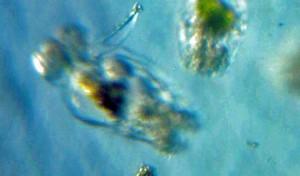Odling rotiferer hemma är ganska lätt att göra. Rotiferer är en utmärkt födokälla för nykläckta fisklarver och för vissa filtermatande ryggradslösa djur. Ironiskt nog är den rotifer organismen i sig ger mycket lite näringsvärde till de djur som äter dem.
 Det är innehållet i deras inälvor (maten de äter) som ger dem näring. Det är därför viktigt att utfodra din rotiferer med en mycket näringsrik matkälla, t.ex. fytoplankton. Om du menar allvar med att odla roterfiskar hemma bör du överväga att också odla fytoplankton. Det är viktigt att hålla kulturerna åtskilda och undvika kontaminering, men de färdigheter som krävs för att odla fytoplankton och roterfiskar är likartade. För mer information om fytoplanktonodling kan du gå in på sidan om fytoplankton.
Det är innehållet i deras inälvor (maten de äter) som ger dem näring. Det är därför viktigt att utfodra din rotiferer med en mycket näringsrik matkälla, t.ex. fytoplankton. Om du menar allvar med att odla roterfiskar hemma bör du överväga att också odla fytoplankton. Det är viktigt att hålla kulturerna åtskilda och undvika kontaminering, men de färdigheter som krävs för att odla fytoplankton och roterfiskar är likartade. För mer information om fytoplanktonodling kan du gå in på sidan om fytoplankton.
Det finns två populära sätt att odla rotiferer: som en kontinuerlig odling eller som en satsodling. I följande blogginlägg presenteras det protokoll som jag följer för att odla rotiferer i en satsodling hemma.
Uppläggning och protokoll för Rotifer Batch Culture
- Cut 3 lengths of 12-inch rigid tubing and 4 lengths of flexible tubing: 3 long enough to reach from the bottles to the splitter and the fourth long enough to run from the air pump to the splitter Attach flexible tubing to splitter, pump and rigid tubing. Insert rigid tubing into culture bottle Turn on the air pump Fill bottles with a small amount of freshwater to test and make sure all 3 airlines create a modest flow of bubbles. Adjust the flow rate on the splitter as necessary to create a uniform moderate flow. Empty the bottles and inoculate the first bottle with a starter rotifer culture Add a few ounces of phytoplankton, make sure aeration is on, and watch the culture over each of the next few days. When the water ‘clears’ to a light green tea-colored tint, and you can see little specs in the water when you hold the bottle up to a bright light, add a few ounces more phytoplankton. Over a few days, by adding more phytoplankton when the culture clears, increase the total culture volume to about 3⁄4 of the bottle (about 1.5L After another 1-2 more days, once the1.5 liters of rotifers have cleared the phytoplankton, it’s time to start your second culture. Take approximately 1/3 of the culture (approximately 0.5L) of the tea-colored liquid and pour it into a second plastic bottle. Fill each of the bottles to the top with phytoplankton. In this way, the original bottle will be ready to harvest about a day before the second bottle. Repeat this step to create as many culture bottles as you want. By varying the mixture of phytoplankton volume and rotifer culture volume (or density) you can optimize your cultures to be ready for harvest when you will need it. To harvest the rotifers, pour out about 3⁄4 of the tea-colored culture through a rotifer sieve (approximately 50-55 micron) and into a discard/water change bucket After you have ‘filtered’ 3⁄4 of the culture through the rotifer sieve, turn the sieve upside down over second bucket (or small office-sized trash can dedicated to fish-room use), scoop up a cupful of the discarded culture water and pour it slowly over the upside-down rotifer sieve, effectively reversing the flow of water and rinsing the collected rotifers into your collection bucket/trash can. Collect the concentrated rotifers, feed them to your tank or store them in the refrigerator for later Fill the rest of the bottle (the remaining 1.5 liters), with fresh phytoplankton and start bubbling again Saltvattenakvarium bloggtips : Istället för att skölja roteringarna från rotifersiktet med kasserat odlingsvatten kan du ersätta det med vatten från ditt akvarium eller med färskt saltvatten. På så sätt kan du tillsätta roteringar till ditt akvarium utan att tillsätta orenheter från odlingsvattnet. Tips för avancerade akvarister : Nyckeln till att överleva kulturkrascher - som du kommer att råka ut för - är redundans. Du vill alltid ha flera kulturer som fungerar samtidigt. Om du gör det är chansen stor att åtminstone några rotiferer från en av kulturerna kommer att överleva. Lägg den eller de kraschade kulturerna åt sidan, skaffa nya plastflaskor och använd de överlevande för att så en ny omgång.
Detta är det tredje inlägget i en serie om odling av rotiferer i saltvatten.
För att återgå till det tidigare inlägget om den utrustning som krävs för att odla rotiferer, klicka här.
För att fortsätta till nästa inlägg om kontinuerliga rotiferkulturer, klicka här.

